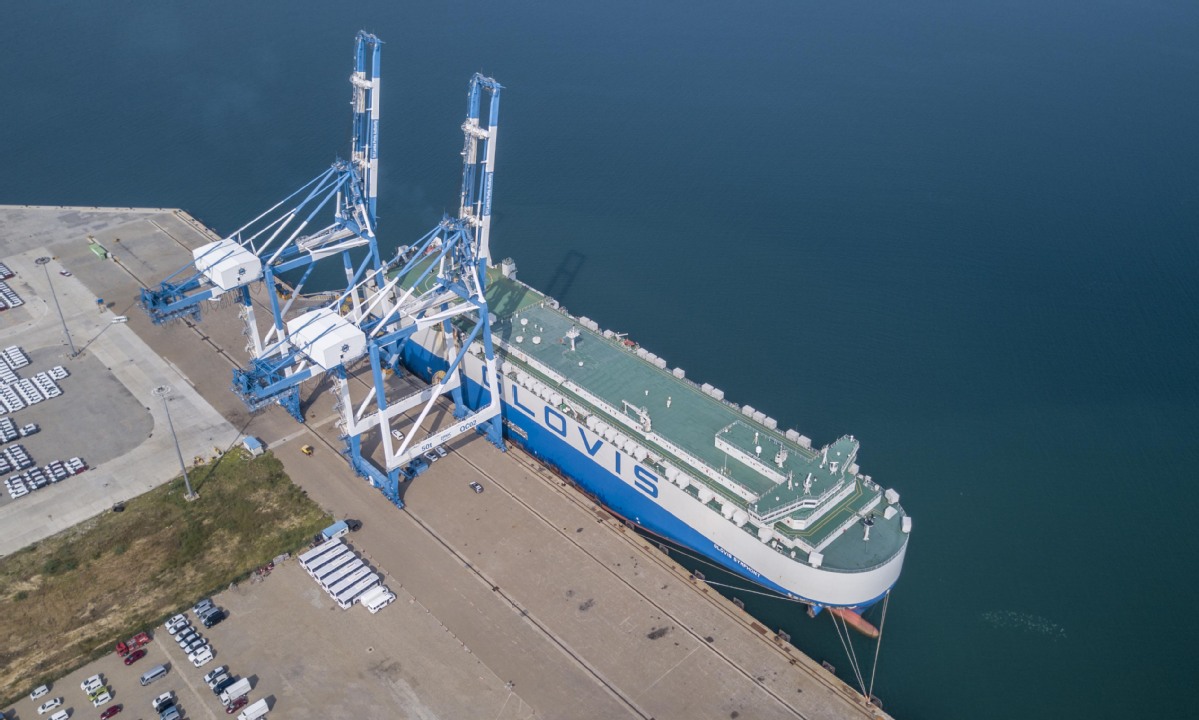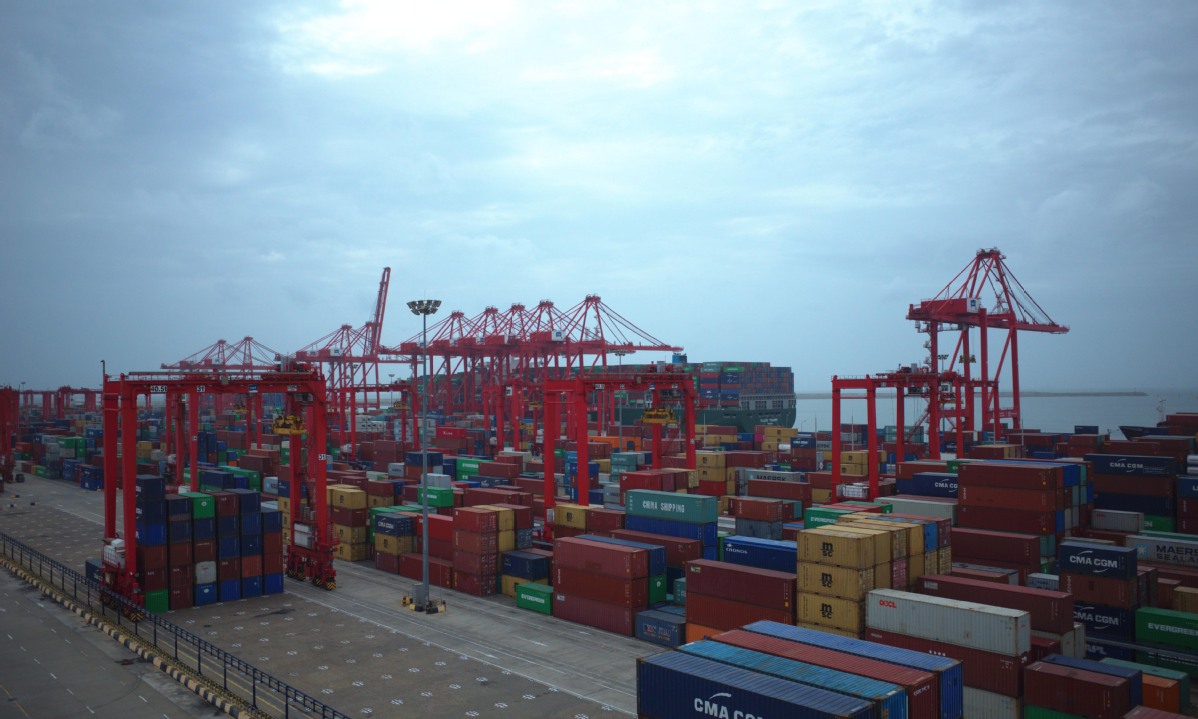Joint venture sets Sri Lankan port buzzing again
Island nation looks to development model used in Shenzhen, Pan Mengqi reports in Sri Lanka.
A fishing town in one of the most underdeveloped regions in Sri Lanka is taking a leaf out of Shenzhen's book.
The town is looking to the development model used at a port in the city in Guangdong province to help fuel economic growth in the Indian Ocean island nation.
Hambantota is on Sri Lanka's south coast. A few years ago, the southwest area of the town was merely jungle. Some wooden fishing boats lay stranded on the beach, and fishermen would often see snakes, elephants and peacocks in the area, according to Yuri Kannangara, a local.
Kannangara has worked in the shipping industry for the past 20 years. But the 51-year-old has spent much of that time away from his loved ones, working in South African ports as a mechanic. Job prospects and salaries there are more competitive, which is important as he has a five-member family to support.
Hambantota, his home town, lies within just 20 kilometers of one of the world's busiest shipping lanes, through which some 200 to 300 vessels daily carry two-thirds of global energy products and half of all containerized cargo.
But the town's port remained neglected for decades, and Hambantota witnessed a long period of low development due to a lack of industry and basic infrastructure, not to mention a modern commercial port.
Things have changed in just a year.
In July last year, Sri Lanka and China signed a joint venture agreement to begin operations at Hambantota Port. China Merchants Group and Sri Lanka's Ports Authority agreed to jointly operate the port for 99 years through Hambantota International Port Group and Hambantota International Port Services.
Kannangara is now a deputy general manager at the bustling port, in charge of a department that ensures all the fast-developing facility's machinery functions well.
But during the initial phase of the cooperation project, many observers expressed doubts, saying it appeared too difficult and it was not necessary to build an international port in such a poor area.
Feng Ming, a deputy general operations manager at Hambantota Port, said that in the past, the ships used by automakers in East Asia and India had to call at Colombo to refuel or unload vehicles for other destinations. However, with space now limited at that port, efficiency is slowing.
Ships carrying automobiles often need to anchor for 10 days off the Port of Colombo to await vacant berths, which in turn has increased the price of imported vehicles.
A report in 2009 by the Sri Lanka Ports Authority said Colombo handled 4,973 transshipped vehicles, but the number fell to 2,455 the following year. By 2011, just 993 vehicles were handled at the port.
PORT A PRIORITY
In 2005, constructing a new port and connecting it to Colombo via a planned industrial belt was prioritized in Sri Lanka's "Mahinda Vision for the Future", proposed by former president Mahinda Rajapaksa. This aims to transform Sri Lanka into "a hub for sea transport, aviation, business, energy and knowledge".
Rajapaksa believed Sri Lanka needed a new economic growth engine, and Hambantota Port, close to the world's busiest shipping lanes, proved to be a good option.
"But Sri Lanka has a very weak industrial base, so there's little internal demand," Feng said of the challenges being faced. "We are developing this port very slowly, but steadily".
Feng said the model Hambantota International Port Group has adopted to develop Hambantota is the "port-parkcity" model, where an industrial park and a city are built after the initial development of a port. This model has catapulted the once-backward fishing port of Shekou in Shenzhen into a modern city.
The joint venture will set up an industrial zone at the port. It is hoped that the zone will act as an engine to drive economic development in the region, and gradually attract investors worldwide.
In the first half of this year, the joint venture between China and Sri Lanka, which was formally started in December, attracted 142 ships to berth at its docks, more than the number of vessels handled by the Port of Hambantota in the whole of last year.
Tissa Wickramasinghe, HIPG's chief operations officer, said automakers from Japan, South Korea and India have begun transshipping increasing numbers of vehicles through Hambantota, attracted by its convenient location, deep-water berths and the availability of storage space.
Since December, 55,959 cars have been shipped through Hambantota.
"Also, in less than a year, the value of land in the Hambantota area has increased three or four times, wages have tripled and rents have doubled," Wickramasinghe added.
Parakrama Dissanayake, chairman of the Sri Lanka Ports Authority, said, "You have one of the world's most experienced companies running the port."
He added that many countries together with international contractors and financial institutions competed for the contract to build Hambantota Port, but China Merchant Group offered the best proposal. This not only took into account building a port, but also considered how the port could be used to drive regional development.
In 1872, Li Hongzhang, a minister in the Qing Dynasty (1644-1911) who tried to modernize China, recruited Zhu Qi'ang, who had handled shipping for many years, to discuss trialing a new type of port authority in China. The China Merchants Steamship Navigation Co, established in Shanghai, became the predecessor of China Merchant Group.
At that time, Li and his company were struggling to break colonizers' monopoly on Yangtze River inland shipping. Today, CMG is one of the world's largest and most competitive companies in the transportation and aviation businesses.
It has built ports and highways in various countries to boost international connectivity, but the company believes that connectivity between people sometimes outweighs its huge construction programs.
HAPPY TO HELP
At Colombo International Container Terminals, a subsidiary of CMG that builds and operates the South Container Terminal at the Port of Colombo, Chinese and Sri Lankan employees call each other "brother".
Whenever CICT chief executive officer Huang Peng received a phone call from a Sri Lankan colleague, he always started the conversation with "Hello my brother". His mantra became a buzzword within the company, and soon many started to imitate Huang's style of greeting.
Huang's office door is always open, and as CEO, he is happy to deal with his Sri Lankan employees' different requests and questions. "Some are about meals at work and salaries, some others are about family and relationship issues. But I'm happy to help them solve all types of issues," he said.
CICT has 1,500 employees, of which more than 1,480 are Sri Lankan. During the 35-year contract period, CICT expects to add more than $2 billion in revenue to the Sri Lankan economy, bringing in some 5,000 new jobs.
For Thusitha George, the operations manager at CICT, his "best brother" is Zhu Mingwei.
Zhu, who works in the technical department, often helps George solve complex technical problems in his work. As a local employee, George likes to invite his Chinese colleagues to try Sri Lankan black tea after work.
The port was recently ranked the 13th best-connected port in the world by Drewry Port Connectivity Index, a global shipping analyst.
It also won the Best Container Terminal in Asia award in the Under 4 million TEUs (twenty-foot equivalent units) category at the Asian Freight, Logistics and Supply Chain Awards for two consecutive years, which Huang said was the result of the joint efforts by Chinese and Sri Lankan employees.
Ten years ago, the Port of Colombo was on the brink of bankruptcy, due to civil war and the global financial crisis.
Colombo residents have a unique habit. When calculating the distance between the capital and other places, they always take the Old Colombo Lighthouse as the starting point.
The lighthouse, built by the country's colonizer Britain, has witnessed both the prosperity and the suffering of the Port of Colombo.
In 1912, the colonial government established the Colombo Port Commission and modernized the port, and by the 1920s, Colombo had become one of the largest ports in South Asia.
Nearly all the trading vessels traveling between Asia and Europe docked at the port to offload cargo. The lighthouse guided merchant ships from Britain, India, Australia and the Far East.
Eighty-four years later, the lighthouse was severely damaged in an explosion, with the country embroiled in a civil war since 1983 that lasted for nearly 30 years. The area where the lighthouse is located has been under high levels of security for 20 years.
When the civil war ended in 2009, Sri Lanka began to revitalize its economy and rebuild its damaged port business. But then, the financial crisis devastated the global port industry.
TRANSPARENT OFFER
In 2008 and 2009, major container ports in the United States experienced negative growth, and throughput growth at leading ports in Europe and China also fell sharply. The throughput growth rate at Guangzhou Port in Guangdong dropped to 2.9 percent in the third quarter of 2008. Such low growth was unprecedented in the port's hundreds of years of history.
At the time, the port industry's enthusiasm for investing in the Port of Colombo, which was then open for international bidding, was virtually non-existent, with many companies withdrawing their earlier bids. In 2009, only CMG sent a tender to the Sri Lankan government.
Hu Jianhua, vice-president of CMG, said everyone at the company was concerned that the sluggish international economic and trade situation would damage the port industry after the financial crisis.
But Hu believed the crisis was only cyclical, and as a result, it was necessary for China to help Sri Lanka rebuild its economy.
His assessment proved to be correct. In 2010, the crisis eased and several major international port giants proposed better offers to the Sri Lankan government, hoping to re-tender for the project.
"But the Sri Lankan government insisted on handing over the project to China," Hu said.
He said there were two reasons for this. "First, our bidding process is legally compliant and the bid proposal was impeccable and transparent. Second, Sri Lanka respects the spirit of contract, which also proved that we had chosen the right partner to cooperate with."
Soon, the ancient Port of Colombo began to revive.
Under the joint operation between China and Sri Lanka, container throughput at the port increased from 4.18 million TEUs to 5.74 million TEUs between 2012 and 2016. This growth was fueled by CICT.
In 2014, the port became the fastest-growing in the world as its throughput increased by 14 percent. In 2015, this grew by 7 percent, at a time when the global shipping market was in a downturn.
In 2016, CICT's throughput reached 2.02 million TEUs. Now, the century-old port has regained its position as one of the busiest in the region.
- Chinese embassy distributes 5,000 dry ration packs in northern Sri Lanka
- Chinese charitable organization distributes food packages to Sri Lankan students
- Wang Yi meets officials from Sri Lanka, Laos, Nepal, Vietnam
- Sinopec begins fuel delivery to Sri Lanka
- Talk with Ambassadors | BRI to create shared prosperity, Sri Lankan Ambassador to China





